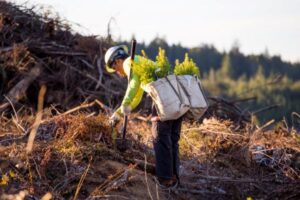
Work. Play. Renew.
What Is Sustainable Forestry?
Humans depend a great deal on the resources provided by forests, which is why it’s crucial we focus on sustainable forestry. Everyone has at least some need for products that are made from wood and wood products, of course, but the importance of forests to the global ecosystem goes far beyond that. The fact is, we simply cannot survive without them: forests provide as much as one-third of the oxygen we breathe. Not only that, forests act as massive carbon sinks, absorbing harmful greenhouse gasses and reducing the effects of climate change.
 Despite all this, the world’s forests continue to shrink at an alarming rate: by around 10 million hectares of forest per year. This destructive pace cannot be allowed to continue if we wish to maintain a healthy planet. However, reducing deforestation poses a difficult challenge, as so much of our society depends on the resources provided by forests. Outside of our planet, there’s the economic element to consider as well: millions of jobs and the livelihoods of countless people depend on our ability to harvest resources from forests.
Despite all this, the world’s forests continue to shrink at an alarming rate: by around 10 million hectares of forest per year. This destructive pace cannot be allowed to continue if we wish to maintain a healthy planet. However, reducing deforestation poses a difficult challenge, as so much of our society depends on the resources provided by forests. Outside of our planet, there’s the economic element to consider as well: millions of jobs and the livelihoods of countless people depend on our ability to harvest resources from forests.
The solution lies in sustainable forestry: a series of management strategies that utilize forest resources responsibly, allowing us to reap the environmental and economic benefits of forests, something Oregon knows a lot about. While deforestation continues to be a global problem, Oregon has strong laws that ensure harvested forests are replanted and discourage conversion of forestland to other uses. We have more trees than we had 100 years ago and have maintained roughly the same number of acres of forestland since 1900.
This article from Oregon Forests Forever will explain how some of these forest management techniques work and how we can all work together to conserve some of our most important natural resources.
Start With a Plan
Responsible use of forest resources begins with careful planning. Each forest has an abundance of resources to provide, and an ability to regenerate within a given timeframe. One of the most important elements of sustainable forestry depends on planning around a forest’s ability to regrow over time.
Creating an effective strategy for the management of forest resources depends on sustainably harvesting less than the forest grows every year. Professional foresters survey the forests and create an inventory that helps determine when and where harvests will take place each year. Often, forest management plans extend decades out into the future, ensuring that decisions made today will provide environmental and economic benefits for future generations. Frequently, these plans need to be updated as conditions change over time. Wildfire, ice, wind and snow storms often knock down or damage trees, which can require professional foresters to shift resources to restore damaged areas.
Protect the Forest With Controlled Burns
One of the most devastating events that can occur in a forest is an uncontrolled wildfire. Regardless of the original cause, a blaze can spread quickly, using dead or dried-out plant matter as its fuel source. As it does so, it will release carbon-filled smoke into the atmosphere, negatively impacting the health of people living in the area and contributing significantly to climate change. Fires also displace wildlife from their habitats and put vulnerable species at further risk. The financial impacts cannot be ignored either: because forests provide resources, the destruction of those resources can cause great economic harm to the societies that depend on them.
It may seem like a contradiction, but one of the ways that forestry workers protect the forest is through thinning and the use of occasional controlled burns. While it can be destructive, fire is also necessary in order to return vital nutrients to the soil and clear away dead vegetation. Using carefully controlled burns, forest workers can help contribute to sustainable forestry by limiting the worst effects of wildfires while still producing carbon-friendly building materials.
Balance Logging With Planting
Responsible use of resources also means ensuring resources continue to be available for future generations. This means replanting areas that have been harvested or damaged by wildfire or weather. Replanting helps ensure forests continue to provide clean air and water, wildlife habitat, recreation opportunities, green jobs and wood products.
Replanting a forest is a fairly complex process, one that requires a large number of people to work together to create a new thriving forest. Seedlings must be carefully chosen, cultivated and planted, protected from grazing by deer and other wildlife and kept safe from competing vegetation and invasive species. Over time, the seedlings will grow strong enough to establish a thriving new forest, but this can often take years.
The fact that reforestation is such a massive process can actually be a blessing in disguise. Because it requires so many people with specialized jobs working in tandem, it can be a major job creator for local communities. Sustainable forestry practices help to create green jobs in the local economy. For this reason, efforts like Oregon Forests Forever work together with local businesses and governments to ensure sustainable practices are implemented in areas that depend on forests for both their natural benefits and economic resources. Learn more by exploring our website.